Today, continuing my plan to post photos of excellent traditional masks from the Mexican state of Guerrero, I will show masks of Tigres, the Spanish word used to refer to jaguars.
According to Santano González Villalobos (2005), in Danzas y Bailes Tradicionales del Estado de Guerrero, there are various dances in this state that include dancers wearing jaguar masks. These include el danza de los Tlacololeros (pages 66 to 84), the danza de los Tecuanis or Tecuanes (pages 85 to 91), la danza del Tigre y los Tlaminques (pages 91 and 93), the famous danza de los Tigres de Zitlala (pages 92 and 99) in which dancers wearing leather helmet masks batter one another with clubs made from coiled rope, and la danza del Tigre (page 93).
I will begin by showing a leather Tigre mask from Zitlala, Guerrero. It is in the collection of Helmut Hamm, a recent visitor to this site from Germany. It looks like a good one.
Here is a link to a Youtube™ video showing the Tigres in Zitlala. Their dance and related suffering is said to represent a petition for rain.
https://www.youtube.com/watch?v=YKmIOyjeeL4
Next I will show again a leather Tigre that I photographed in the collection of Charles Thurow and included in an earlier post, on August 18, 2014. You will see how similar it is to the mask of Helmut Hamm.
The height of the leather Tigre is 11 inches, the width is 13 inches, and the depth is 10 inches
The rest of this post will focus on Tigre masks from Chilapa, Guerrero, another place where such masks are extremely prominent. Here is a YouTube video of the jaguars dancing there in 2014. It contains many other interesting elements as well. Observe closely for a dancer wearing a caiman step-in mask, early in the video. He lashes those around him with his long rubber tail.
https://www.youtube.com/watch?v=qCetd4Ikh3Y
As you may have noticed in the video, dancers of all ages participate in this performance. I will show three jaguar masks of paper mache that were said to have been worn by children. Then I will continue with four wooden masks that are just like those worn by adult dancers in the video. All of these masks were collected in Chilapa by Jaled Muyaes and Estela Ogazon, probably in the 1970s.
The paper mache Tigre masks are unusual and charming. All three masks have inlaid disks made from mirror glass for the eyes, just as the larger wooden masks do. The dancer wears the mask on his forehead and looks out through the open mouth. Each mask has thorn teeth. These masks were constructed with pages from children’s workbooks. Some of the pages have colored illustrations.
The largest of the paper mache masks is 10 inches tall, 7½ inches wide, and 6 inches deep. This easily fits on my face, and the faces of the Nahua Indians are smaller than mine.
Note the colored illustrations on the paper that was used to construct this mask. All three of the paper mache Tigre masks also have a hand painted cloth flap on the back.
The second paper mache mask is also large enough to fit on my face, although barely so, at 9 inches tall, 6 inches wide, and 5 inches deep.
This mask was constructed with pages from a childrens’ workbook.
The smallest of the three paper mache masks is indeed too small for an adult to wear. The height is 8 inches, the width is 6½ inches, and the depth is 5 inches.
Despite the differences in size, these three masks share the same method of construction.
In contrast to the paper mache masks, most of the wooden ones are oversized. However, I will start with one that is smaller. Like those of paper mache, the wooden masks lack openings for vision; the dancer looks out through the large open mouth of the mask.
This is the first of the wooden masks. Like the three paper mache masks, this was has a flap in the back, but this flap is painted leather, stiff and strong. Because this flap rests squarely on the back of the dancer’s head, it tends to anchor the mask. The front edge of the mask rests on the dancer’s lower lip!
This mask is 9 inches tall, 6 inches wide, and 5 inches deep. The measurement from the forehead to the back edge of the leather flap is 11 inches.
The next three masks are oversized, which is typical for the wooden Tigre masks danced at Chilapa, and all three have wide mouths that are rounded at the corners. Here is the first of the oversized masks.
The height of this mask is 14½ inches, the width is 10 inches, and the depth is 5½ inches.
Because these oversized masks are worn on the forehead, the staining from use is most apparent at the lower edge of the back of the mask. Perhaps the dancers wear cloth caps or head covering, because what one sees at the center is a spot worn bare, rather that a point of heavy staining.
Here is the second of the oversized masks.
The height of this mask is 15 inches, the width is 11 inches, and the depth is 7 inches.
Here is the third of the oversized masks.
An old belt has furnished leather for the tongue, which is a common practice. The height of this mask is 14 inches, the width is 11½ inches, and the depth is 7 inches.
Notice how the bristles are formed from loops of hair. On this mask the spot in the middle is heavily stained rather than polished from use.
Next week I will continue to discuss the jaguar masks from the state of Guerrero.

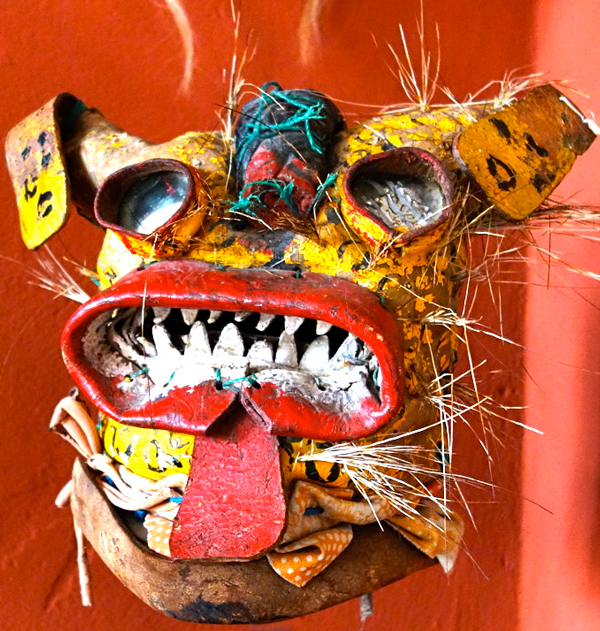
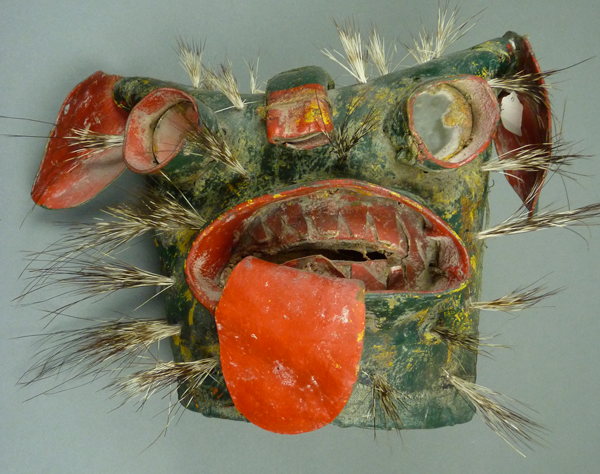

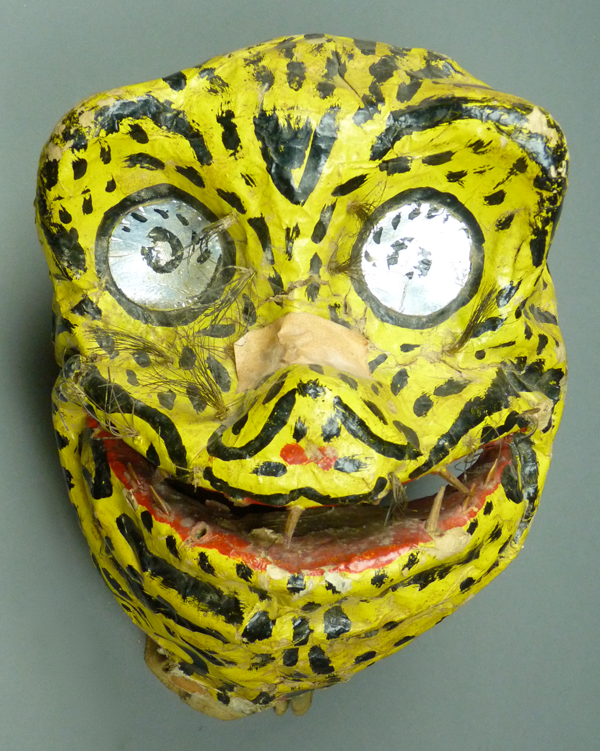
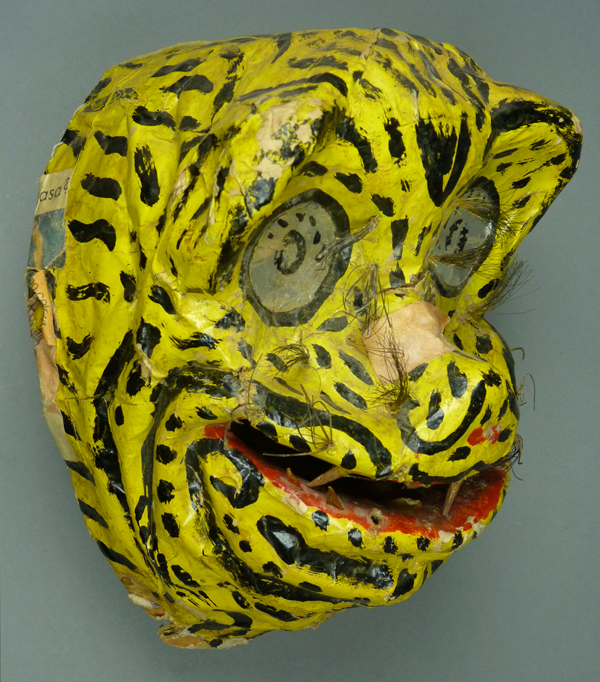

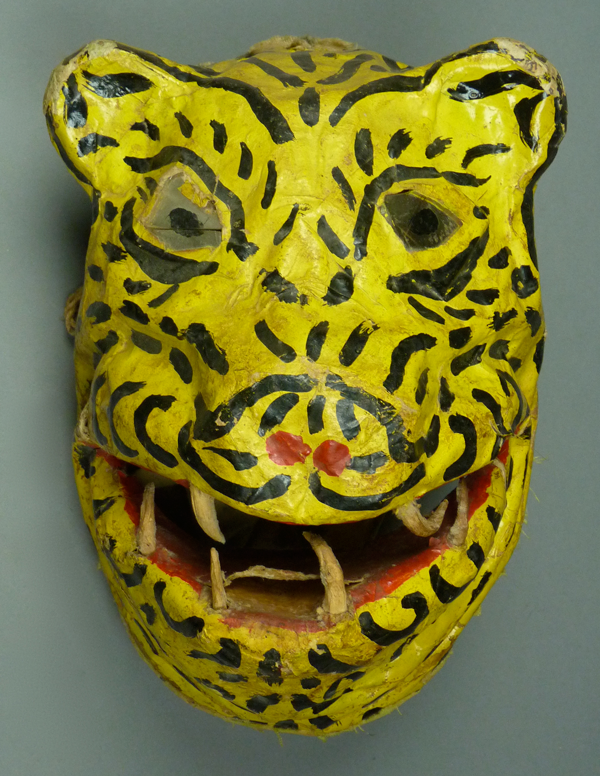


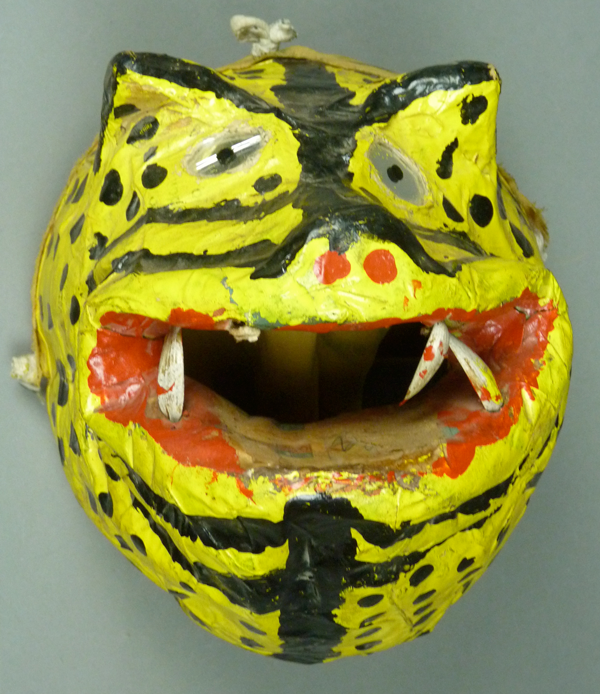
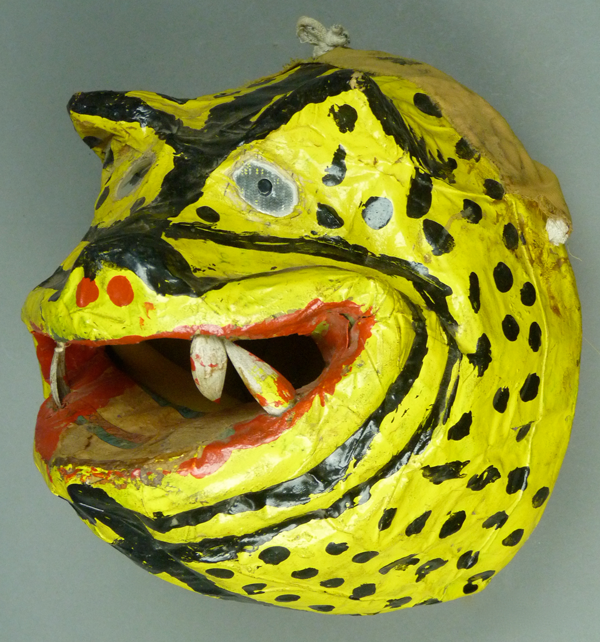

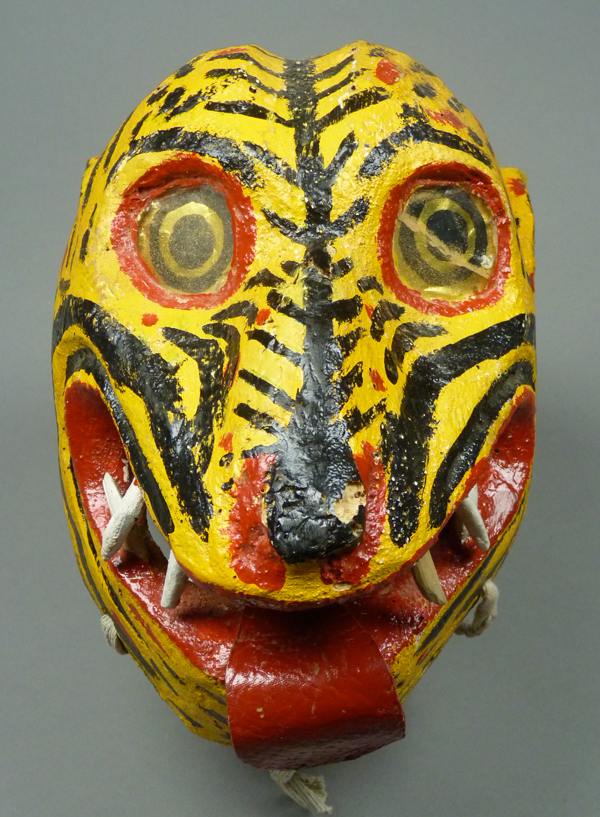

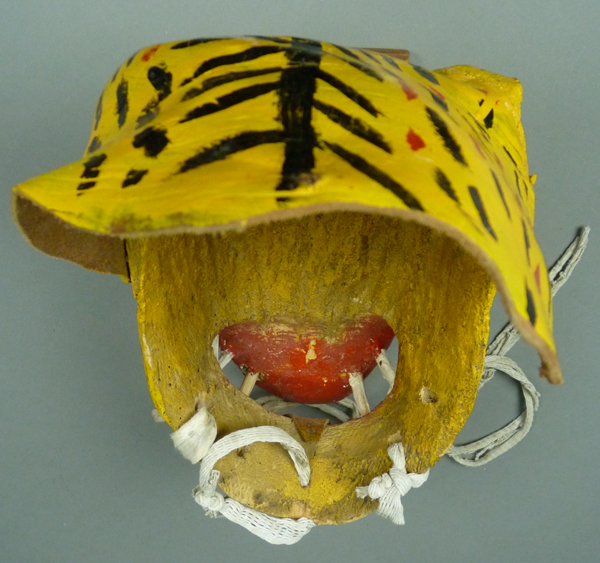
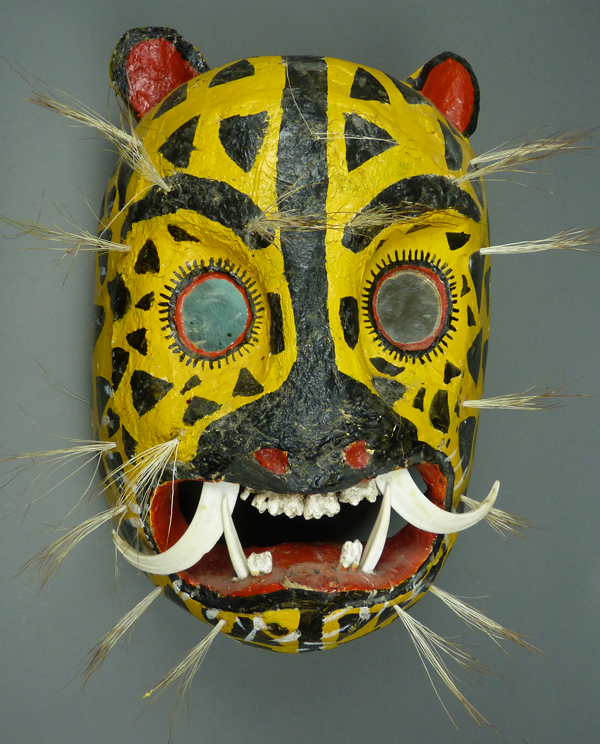

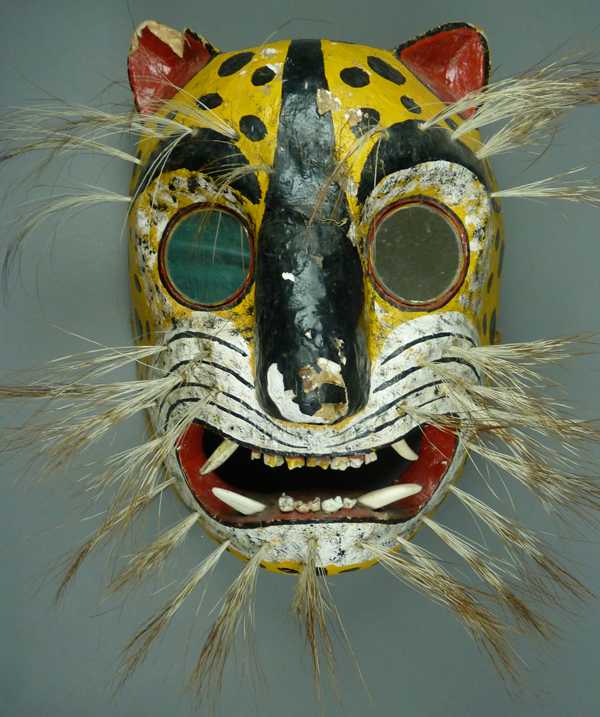


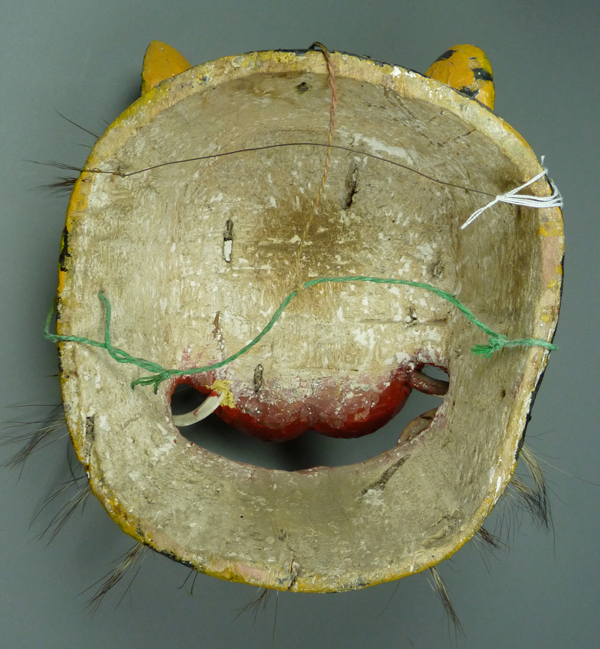
Dear, do you sell these masks ? Thanks and regards
Nathalie Matter
Hello
At this time I am keeping all of these groups of masks together- jaguars from Guerrero, clowns from Puebla, …
In the future I would prefer to sell them in such clusters. In general, most of the masks I have shown are becoming increasingly rare.
Thanks for asking.
Bryan
This is very helpful, as I have used this for my Art homework.
Thanks,
What kind of hair is used in the older el tigre mask? I have some old ones with hair missing in places and want to buy the proper animal hair to replace certain spots. Do you sell this hair?
John
As far as I know, these masks are haired with pig bristles. I don’t sell such stuff, but the Chinese apparently do.
https://www.alibaba.com/showroom/pig-bristles.html
Also you can buy chinese beekeeper brushes through ebay and dismantle them for the hair.
Horse hair (horse taiL) would not be stiff enough.
I hope that helps.
Bryan Stevens
Hello,
I’m so intrigued by this site, and the wealth of knowledge and images you share. I understand that many of them are rare and probably hard to find it at all possible. They are beautiful!
I work as an artist and wondered if you would mind if I used a few images for inspiration,
I’m doing some fiber work and would like to use a couple.Embroidery or quilting? I would certainly give credit to you and for the inspiration, you’re work and study.
Thanks for any consideration. Please feel free to ask for examples.
Cal Navin